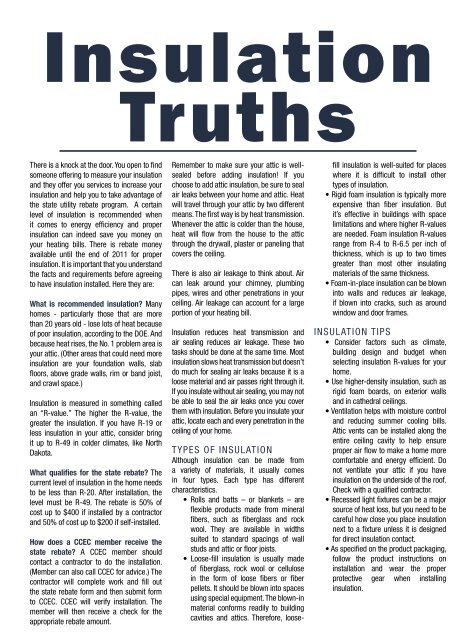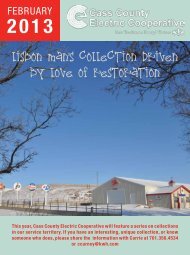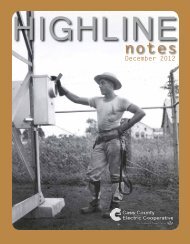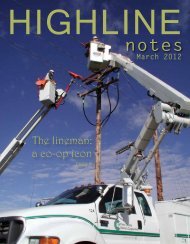AUGUST - Cass County Electric Cooperative
AUGUST - Cass County Electric Cooperative
AUGUST - Cass County Electric Cooperative
Create successful ePaper yourself
Turn your PDF publications into a flip-book with our unique Google optimized e-Paper software.
Insulation<br />
Truths<br />
There is a knock at the door. You open to find<br />
someone offering to measure your insulation<br />
and they offer you services to increase your<br />
insulation and help you to take advantage of<br />
the state utility rebate program. A certain<br />
level of insulation is recommended when<br />
it comes to energy efficiency and proper<br />
insulation can indeed save you money on<br />
your heating bills. There is rebate money<br />
available until the end of 2011 for proper<br />
insulation. It is important that you understand<br />
the facts and requirements before agreeing<br />
to have insulation installed. Here they are:<br />
What is recommended insulation? Many<br />
homes - particularly those that are more<br />
than 20 years old - lose lots of heat because<br />
of poor insulation, according to the DOE. And<br />
because heat rises, the No. 1 problem area is<br />
your attic. (Other areas that could need more<br />
insulation are your foundation walls, slab<br />
floors, above grade walls, rim or band joist,<br />
and crawl space.)<br />
Insulation is measured in something called<br />
an “R-value.” The higher the R-value, the<br />
greater the insulation. If you have R-19 or<br />
less insulation in your attic, consider bring<br />
it up to R-49 in colder climates, like North<br />
Dakota.<br />
What qualifies for the state rebate? The<br />
current level of insulation in the home needs<br />
to be less than R-20. After installation, the<br />
level must be R-49. The rebate is 50% of<br />
cost up to $400 if installed by a contractor<br />
and 50% of cost up to $200 if self-installed.<br />
How does a CCEC member receive the<br />
state rebate? A CCEC member should<br />
contact a contractor to do the installation.<br />
(Member can also call CCEC for advice.) The<br />
contractor will complete work and fill out<br />
the state rebate form and then submit form<br />
to CCEC. CCEC will verify installation. The<br />
member will then receive a check for the<br />
appropriate rebate amount.<br />
Remember to make sure your attic is wellsealed<br />
before adding insulation! If you<br />
choose to add attic insulation, be sure to seal<br />
air leaks between your home and attic. Heat<br />
will travel through your attic by two different<br />
means. The first way is by heat transmission.<br />
Whenever the attic is colder than the house,<br />
heat will flow from the house to the attic<br />
through the drywall, plaster or paneling that<br />
covers the ceiling.<br />
There is also air leakage to think about. Air<br />
can leak around your chimney, plumbing<br />
pipes, wires and other penetrations in your<br />
ceiling. Air leakage can account for a large<br />
portion of your heating bill.<br />
Insulation reduces heat transmission and<br />
air sealing reduces air leakage. These two<br />
tasks should be done at the same time. Most<br />
insulation slows heat transmission but doesn’t<br />
do much for sealing air leaks because it is a<br />
loose material and air passes right through it.<br />
If you insulate without air sealing, you may not<br />
be able to seal the air leaks once you cover<br />
them with insulation. Before you insulate your<br />
attic, locate each and every penetration in the<br />
ceiling of your home.<br />
TYPES OF INSULATION<br />
Although insulation can be made from<br />
a variety of materials, it usually comes<br />
in four types. Each type has different<br />
characteristics.<br />
• Rolls and batts – or blankets – are<br />
flexible products made from mineral<br />
fibers, such as fiberglass and rock<br />
wool. They are available in widths<br />
suited to standard spacings of wall<br />
studs and attic or floor joists.<br />
• Loose-fill insulation is usually made<br />
of fiberglass, rock wool or cellulose<br />
in the form of loose fibers or fiber<br />
pellets. It should be blown into spaces<br />
using special equipment. The blown-in<br />
material conforms readily to building<br />
cavities and attics. Therefore, loosefill<br />
insulation is well-suited for places<br />
where it is difficult to install other<br />
types of insulation.<br />
• Rigid foam insulation is typically more<br />
expensive than fiber insulation. But<br />
it’s effective in buildings with space<br />
limitations and where higher R-values<br />
are needed. Foam insulation R-values<br />
range from R-4 to R-6.5 per inch of<br />
thickness, which is up to two times<br />
greater than most other insulating<br />
materials of the same thickness.<br />
• Foam-in-place insulation can be blown<br />
into walls and reduces air leakage,<br />
if blown into cracks, such as around<br />
window and door frames.<br />
INSULATION TIPS<br />
• Consider factors such as climate,<br />
building design and budget when<br />
selecting insulation R-values for your<br />
home.<br />
• Use higher-density insulation, such as<br />
rigid foam boards, on exterior walls<br />
and in cathedral ceilings.<br />
• Ventilation helps with moisture control<br />
and reducing summer cooling bills.<br />
Attic vents can be installed along the<br />
entire ceiling cavity to help ensure<br />
proper air flow to make a home more<br />
comfortable and energy efficient. Do<br />
not ventilate your attic if you have<br />
insulation on the underside of the roof.<br />
Check with a qualified contractor.<br />
• Recessed light fixtures can be a major<br />
source of heat loss, but you need to be<br />
careful how close you place insulation<br />
next to a fixture unless it is designed<br />
for direct insulation contact.<br />
• As specified on the product packaging,<br />
follow the product instructions on<br />
installation and wear the proper<br />
protective gear when installing<br />
insulation.















